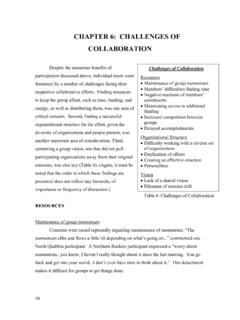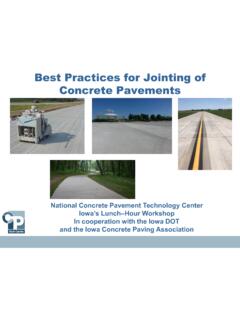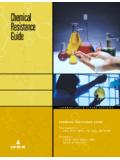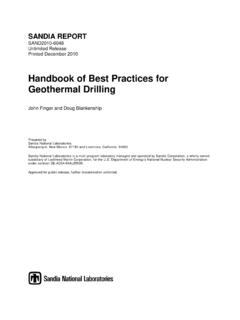Transcription of NIBCO CHEMICAL RESISTANCE GUIDE FOR VALVES & FITTINGS
1 1 NIBCO INC. World Headquarters n 1516 Middlebury St. n Box 1167 n Elkhart, IN 46515-1167 INTRODUCTIONThis CHEMICAL RESISTANCE GUIDE has been compiled to assist thepiping system designer in selecting CHEMICAL resistantmaterials. The information given is intended as a GUIDE only. Manyconditions can affect the material choices. Carefulconsideration must be given to temperature, pressure and chemi-cal concentrations before a final material can be and elastomers physical characteristics are moresensitive to temperature than metals. For this reason, a rating charthas been developed for RATINGSFOR THERMOPLASTICS & ELASTOMERSTemp. in F= A rating, maximum temperature whichis recommended, resistant under normalconditionsB to Temp.
2 In F = Conditional RESISTANCE , consult factoryC= Not recommendedBlank= No data availableMATERIAL RATINGS FOR METALSA= Recommended, resistant under normalconditionsB= Conditional, consult factoryC= Not recommendedBlank= No data availableTemperature maximums for thermoplastics, elastomers and met-als should always fall within published temp/pressure ratings forindividual VALVES . THERMOPLASTICS ARE NOT RECOM-MENDED FOR COMPRESSED AIR OR GAS GUIDE considers the RESISTANCE of the total valve assembly aswell as the RESISTANCE of individual trim and fitting materials. Therating assigned to the valve body plus trim combinations is al-ways that of the least resistant part. In the cases where the valvebody is the least resistant, there may be conditions under whichthe rate of corrosion is slow enough and the mass of the bodylarge enough to be usable for a period of time.
3 Such use shouldalways be determined by test before installation of the componentin a piping the selection of a butterfly valve for use with a particular chemi-cal, the liner, disc, and stem must be resistant. All three materialsshould carry a rating of A. The body of a properly functioningbutterfly valve is isolated from the chemicals being handled andneed not carry the same & ELASTOMERSABS Acrylonitrile Butadiene Styrene Class 4-2-2 conformingto ASTM D1788 is a time-proven material. The smooth inner sur-face and superior RESISTANCE to deposit formation makes ABS drain,waste, and vent material ideal for residential and commercial sani-tary systems. The residential DWV system can be exposed in ser-vice to a wide temperature span.
4 ABS-DWV has proven satisfac-tory for use from -40 F to 180 F. These temperature variationscan occur due to ambient temperature or the discharge of hotliquids into the system. ABS-DWV is very resistant to a wide vari-ety of materials ranging from sewage to commercial householdchemical formulations. ABS-DWV is joined by solvent cementingor threading and can easily be connected to steel, copper, or castiron through the use of transition Chlorinated Polyvinyl Chloride Class 23447-B, formerlydesignated Type IV, Grade 1 conforming to ASTM D-1784, hasphysical properties at 73 F similar to those of PVC, and its chemi-cal RESISTANCE is similar to or generally better than that of , with a design stress of 2000 psi and maximum servicetemperature of 210 F, has proven to be an excellent material forhot corrosive liquids, hot or cold water distribution, and similarapplications above the temperature range of PVC.
5 CPVC is joinedby solvent cementing , threading or (Polypropylene) Type 1 Polypropylene is a polyolefin, whichis lightweight and generally high in CHEMICAL Type 1 polypropylene conforming to ASTM D-2146 isslightly lower in physical properties compared to PVC, it is chemi-cally resistant to organic solvents as well as acids and , polypropylene should not be used in contact with strongoxidizing acids, chlorinated hydrocarbons, and aromatics. With adesign stress of 1000 psi at 73 F, polypropylene has gained wideacceptance where its RESISTANCE to sulfur-bearing compounds isparticularly useful in salt water disposal lines, crude oil piping,and low pressure gas gathering systems. Polypropylene has alsoproved to be an excellent material for laboratory and industrialdrainage where mixtures of acids, bases, and solvents are in-volved.
6 Polypropylene is joined by the thermo-seal fusion process,threading or flanging. At 180 F, or when threaded, PP should beused for drainage only at a pressure not exceeding 20 Polyvinyl Chloride Class 12454-B, formerly designatedType 1, Grade 1. PVC is the most frequently specified of all ther-moplastic materials. It has been used successfully for over 30years in such areas as CHEMICAL processing, industrial plating,chilled water distribution, deionized water lines, CHEMICAL drain-age, and irrigation systems. PVC is characterized by high physi-cal properties and RESISTANCE to corrosion and CHEMICAL attack byacids, alkalies, salt solutions, and many other chemicals. It is at-tacked, however, by polar solvents such as ketones, some chlori-nated hydrocarbons and aromatics.
7 The maximum service tem-perature of PVC is 140 F. With a design stress of 2000 psi, PVChas the highest long-term hydrostatic strength at 73 F of any ofthe major thermoplastics being used for piping systems. PVC isjoined by solvent cementing , threading, or (Polyvinylidene Fluoride) KEM-TEMP (KYNAR ) is astrong, tough and abrasion-resistant fluorocarbon material. It re-sists distortion and retains most of its strength to 280 F. It is chemi-cally resistant to most acids, bases, and organic solvents and isideally suited for handling wet or dry chlorine, bromine and otherhalogens. No other solid thermoplastic piping components canapproach the combination of strength, CHEMICAL RESISTANCE andworking temperatures of PVDF.
8 PVDF is joined by the thermo-seal fusion process, threading or EPDM is a terpolymer elastomer made from ethylene-propylene diene monomer. EPDM has good abrasion and tearresistance and offers excellent CHEMICAL RESISTANCE to a variety ofacids and alkalines. It is susceptible to attack by oils and is notrecommended for applications involving petroleum oils, strongNIBCO CHEMICAL RESISTANCE GUIDE FOR VALVES & FITTINGS2 NIBCO INC. World Headquarters n 1516 Middlebury St. n Box 1167 n Elkhart, IN 46515-1167acids, or strong alkalines. It has exceptionally good weather agingand ozone RESISTANCE . It is fairly good with ketones and alcoholsand has an excellent temperature range from -20 F to 250 (CSM) Hypalon has very good RESISTANCE to oxida-tion, ozone, and good flame RESISTANCE .
9 It is similar to neopreneexcept with improved acid RESISTANCE where it will resist such oxi-dizing acids as nitric, hydrofluoric, and sulfuric acid. Abrasion re-sistance of Hypalon is excellent, about the equivalent of and solvent RESISTANCE is somewhat between that of neopreneand nitrile. Salts have little if any effect on Hypalon. Hypalon is notrecommended for exposure to concentrated oxidizing acids, es-ters, ketones, chlorinated, aromatic and nitro has a normal temperature range of -20 F to 200 (CR) Neoprenes were one of the first syntheticrubbers developed. Neoprene is an all-purpose polymer with manydesirable characteristics and features high resiliency with low com-pression set, flame RESISTANCE , and is animal and vegetable oilresistant.
10 Neoprene is principally recommended for food and bev-erage service. Generally, neoprene is not affected by moderatechemicals, fats, greases, and many oils and solvents. Neoprene isattacked by strong oxidizing acids, most chlorinated solvents, es-ters, ketones, aromatic hydrocarbons, and hydraulic fluids. Neo-prene has a moderate temperature range of -20 F to 160 (NBR) (BUNA-N) is a general purpose oil-resistantpolymer known as nitrile rubber. Nitrile is a copolymer of butadi-ene and acrylonitrile and has a moderate temperature range of-20 F to 180 F. Nitrile has good solvent, oil, water, and hydraulicfluid RESISTANCE . It displays good compression set, abrasion resis-tance and tensile strength. Nitrile should not be used in highly po-lar solvents such as acetone and methyl ethyl ketone, nor should itbe used in chlorinated hydrocarbons, ozone or nitro (FKM) (VITON ) (FLUOREL ) Fluorocar-bon elastomers are inherently compatible with a broad spectrumof chemicals.







